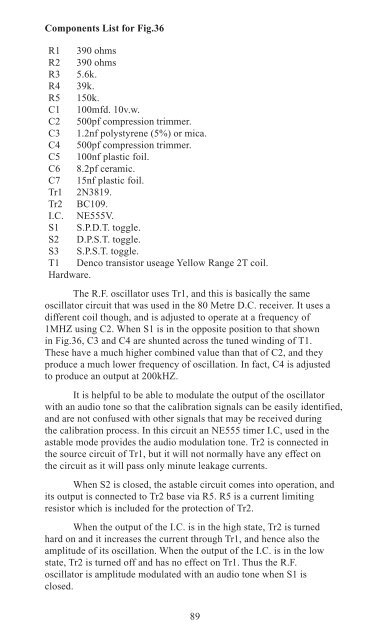Solid State Shortwave Receivers For Beginners - The Listeners Guide
Solid State Shortwave Receivers For Beginners - The Listeners Guide
Solid State Shortwave Receivers For Beginners - The Listeners Guide
Create successful ePaper yourself
Turn your PDF publications into a flip-book with our unique Google optimized e-Paper software.
Components List for Fig.36<br />
R1 390 ohms<br />
R2 390 ohms<br />
R3 5.6k.<br />
R4 39k.<br />
R5 150k.<br />
C1 100mfd. 10v.w.<br />
C2 500pf compression trimmer.<br />
C3 1.2nf polystyrene (5%) or mica.<br />
C4 500pf compression trimmer.<br />
C5 100nf plastic foil.<br />
C6 8.2pf ceramic.<br />
C7 15nf plastic foil.<br />
Tr1 2N3819.<br />
Tr2 BC109.<br />
I.C. NE555V.<br />
S1 S.P.D.T. toggle.<br />
S2 D.P.S.T. toggle.<br />
S3 S.P.S.T. toggle.<br />
T1 Denco transistor useage Yellow Range 2T coil.<br />
Hardware.<br />
<strong>The</strong> R.F. oscillator uses Tr1, and this is basically the same<br />
oscillator circuit that was used in the 80 Metre D.C. receiver. It uses a<br />
different coil though, and is adjusted to operate at a frequency of<br />
1MHZ using C2. When S1 is in the opposite position to that shown<br />
in Fig.36, C3 and C4 are shunted across the tuned winding of T1.<br />
<strong>The</strong>se have a much higher combined value than that of C2, and they<br />
produce a much lower frequency of oscillation. In fact, C4 is adjusted<br />
to produce an output at 200kHZ.<br />
It is helpful to be able to modulate the output of the oscillator<br />
with an audio tone so that the calibration signals can be easily identified,<br />
and are not confused with other signals that may be received during<br />
the calibration process. In this circuit an NE555 timer I.C, used in the<br />
astable mode provides the audio modulation tone. Tr2 is connected in<br />
the source circuit of Tr1, but it will not normally have any effect on<br />
the circuit as it will pass only minute leakage currents.<br />
When S2 is closed, the astable circuit comes into operation, and<br />
its output is connected to Tr2 base via R5. R5 is a current limiting<br />
resistor which is included for the protection of Tr2.<br />
When the output of the I.C. is in the high state, Tr2 is turned<br />
hard on and it increases the current through Tr1, and hence also the<br />
amplitude of its oscillation. When the output of the I.C. is in the low<br />
state, Tr2 is turned off and has no effect on Tr1. Thus the R.F.<br />
oscillator is amplitude modulated with an audio tone when S1 is<br />
closed.<br />
89

















